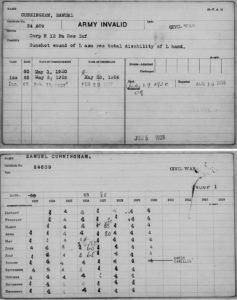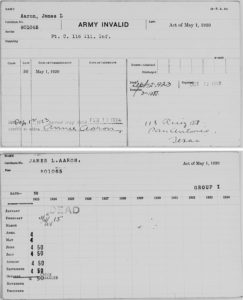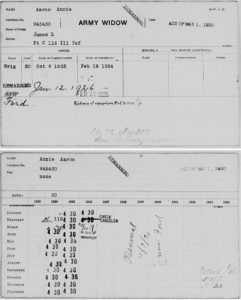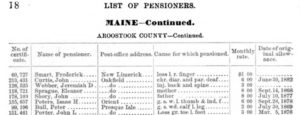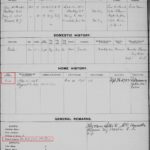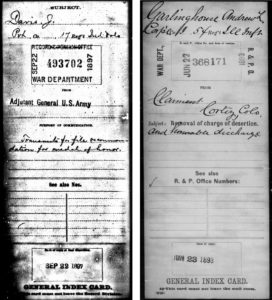Alternative Pension Indexes: When the principal pension indexes don’t include what you want, there are some alternatives. In fact, those alternative indexes sometimes include information about the veteran that is not recorded on any other pension index.
Table of Contents
- PART 1: Introduction
- PART 2: Terminology & Abbreviations
- PART 3: Eligibility
- PART 4: Principal Pension Indexes
PART 5: Alternative Pension Indexes
- PART 6: Case Studies
- PART 7: Getting the Full Pension File
Alternative Pension Indexes
Applies to:
- Union soldiers
Although many of the concepts in this series apply equally to southern records, Confederate pensions were issued by the individual southern states. For more information, see our separate post on Confederate Pensions.
The General Index, Organizational Index, and Numerical Index are the principal tools for finding a Civil War pension. Sometimes those indexes are incomplete or illegible, however. In such cases, these alternatives may provide the information that you need.
But more than that, these alternative indexes may include information that is not recorded on any other other pension index.
In addition to the veteran’s death date and widow’s name, which may (or may not) be recorded in the principal indexes, these additional indexes may identify the veteran’s birth date, death date, enlistment/discharge dates, the nature of his disability, the pensioner’s address, the widow’s remarriage and her death date, among other things.
Each of these resources is limited to a specific date range as specified in its title so it is important to consider whether that date range might be applicable to your soldier.{paymentcards}
The “United States Veterans Administration Pension Payment Cards, 1907-1933”
If your veteran of the Union Army or Navy survived until at least 1907, the online Pension Payment Cards can be a valuable resource. They record the actual payments that were sent to the veteran (“invalid“), his widow, or his dependent(s) from the Veterans Administration between 1907 and 1933. Pension Payment Cards are searchable online at FamilySearch.org (free), Internet Archive (free), Fold3.com ($), and FindMyPast.com ($) but there are significant differences between these sources as described below.
This index contains images of about 2 million cards that were taken from 2539 rolls of microfilm that are housed at the National Archives and Records Administration (NARA) as Record Group 15 and microfilm publication M850. They represent payments during the period 1907-1933 to surviving veterans and widows/dependents of all wars except World War I.
Pro Tip: The Pension Payment Cards started in 1907 and replaced the early system of payment books that were maintained by the Pension Office from 1805 to 1909. These large leather pension payment books have not been digitized, but they are available at the National Archives as part of Record Group 15. Also available in the same collection are the registers of pension certificates up to 1914 and the register of pension applications until 1916.
The front of the card summarizes the pension payments while the back of the card details the individual payments over time. If the pensioner’s death date is not otherwise known, then it can be reasonably estimated by the termination of payments unless another explanation (e.g., remarriage of the widow) is given. This gets to some significant differences between the repositories of Payment Pension Cards:
FamilySearch (free) – Includes both the front and back of each card on sequential images but the veteran and widow cards are sorted separately by the name of each pensioner. If you don’t know the name of the widow, then it may be harder to find her card.
Internet Archive (free) provides a similar index – so it might be used to resolve legibility problems – but in a series of more than 2500 digital books. Insofar as content, it has the same advantages and disadvantages as the one on FamilySearch but takes much more effort to find a specific card. A surname index on FamilySearch Wiki makes it somewhat easier.
Fold3 ($) – Veteran and widow cards are sorted together by the name of the veteran, but only the front of each card is included. So this index is very helpful if you don’t know the name of the widow. But since the back of each card is missing, you can’t examine the history of payments. This is a disadvantage if the pensioner’s death date is not recorded elsewhere.
Pro Tip: As a result of these differences, a productive strategy to maximize the information from this index is to search Fold3 to find the veteran and each person who received a pension with reference to his service (if they survived until at least 1907). Then search the same index in FamilySearch for each of those people in order to examine his/her complete payment history.
The major forms of the Pension Payment Cards are for the Army Invalid, Army Widow, and Army Minor. There are only subtle differences between them. There are three similar cards for Navy veterans.
When the principal indexes are incomplete or illegible, the Pension Payment Card can serve as a good replacement because it will reference the veteran’s Certificate Number (or that of the veteran’s widow, as appropriate), as well as the unit in which he served. As we know, the Certificate Number is key to getting access to the complete pension file.
But even in the event that the soldier and his widow are found in the principal indexes, a veteran’s Pension Payment Cards may include important information that is not recorded in those other indexes, including:
- The veteran’s disability: The veteran’s Pension Payment Card often indicates the nature of his disability.
- The veteran’s death date: The Organizational Index sometimes includes the the veteran’s death date and place at the bottom of the card but that information is often missing from that index. The Pension Payment Card will usually reflect the date of the veteran’s death, marking the termination of his benefit payments.
- The previous pension agency: Payments were made from “pension agencies” in major cities around the country. If the pensioner moved, the paperwork may have been transferred to a different agency in a closer city. So this might give a clue as to the pensioner’s change of residence.
- The specific Act(s) of Congress under which the pension payment was approved: Since each change to pension benefits would spell out the specific qualifications for the recipients to whom it applied, this detail may give insight into the criteria by which the applicant qualified for benefits.
- The veteran’s address(es): to which payments were sent.
- The name of his next of kin: Even if the widow (or parent or other dependent) did not apply for a pension herself, the veteran’s Pension Payment Card may identify her as the recipient of accrued benefits after the veteran’s death.
The Army and Navy Widow cards also include space to record:
- The widow’s name.
- Their year of marriage. (See this case study)
- The widow’s death date: Marking the termination of her benefits.
- The widow’s remarriage: Upon remarriage, the veteran’s widow would be disqualified for further benefits with respect to his service. In that case, the Pension Payment Card may reflect the date of the widow’s remarriage and even her new married name. (In the event of the death of her latter husband, the widow’s benefits might resume under some circumstances.)
- A list of the veteran’s minor children and information from which their birth dates could be calculated: When a veteran’s widow was collecting a pension with respect to his service, she could receive a small amount of extra money for each of their minor children in her care. In order to manage those extra payments, the pension payment card would sometimes include a list of those children and the last date on which each one was eligible for benefits, i.e., the day before the child’s 16th birthday. From that, of course, could be calculated the child’s birthdate. See this case study for an example.
Pro Tip: Don’t make the common mistake of interpreting those dates as the birth or death dates of the children!
Starting in January, 1923, pension payments were made monthly instead of quarterly, and new cards accommodated the change using a new format – so some pensioners had more than one card.
Here, for example, are the Pension Payment Cards for James L. Aaron and his widow, Annie, who have been used as ongoing examples in this series. The veteran had two cards because his pension payments extended from 1907 until his death in September, 1923. His widow started receiving her pension payments in October, 1923, and they ended when she remarried on 12 Jan 1926.
Notice that these cards give his death date as 12 Sep 1923, her remarriage date as 12 Jan 1926, her new surname of Ford, and the addresses in San Antonio, Texas, to which her payments had been sent, among other things which you may not find in any other military records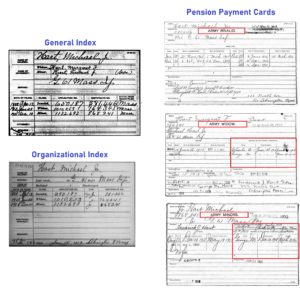
Finally, in relation to a different case, this image shows the “Army Invalid”, “Army Widow”, and “Army Minor” Pension Payment Cards as they were used in succession.
(The General Index and Organizational Index cards for the case are shown for cross-reference.)
Of course, only one of these payment cards was active at a time. That is, the Army Veteran card initially documented payments to him. Upon his death, that card was retired and, upon successful application by his widow, the Army Widow card was created to document subsequent payments to her. Notice that the Army Widow card lists minor children in her care while the Army Minor card was used only when one or more minor child applied as a pensioner in their own right (i.e., after the death of both parents and under the supervision of a guardian).{remarriedwidows}
The “United States Remarried Widows Index to Pension Applications, 1887-1942”
The Index to Remarried Widows is comprised of pension cards for women who remarried after being widowed by a veteran of the War of 1812, Indian Wars, Mexican War, and the Union Army and Navy in the Civil War and later wars. It is searchable online at FamilySearch.org (free), Ancestry.com ($), and part of it is searchable at NARA (free), but there are significant differences between these sources as described below.
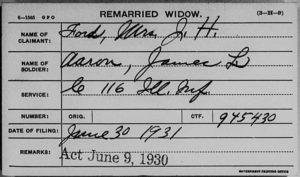
Starting in 1862, the spouse of a qualifying veteran could receive pension benefits upon his death – but those benefits would end if the widow remarried. The law changed in 1901, however, to allow the woman to resume getting the earlier benefits if the latter husband died or if that marriage ended in divorce through no fault of her own, leaving her with no means of support.
Note that a woman may have been widowed by more than one veteran and could receive pension benefits from each – but not at the same time.
This index contains images from 8 rolls of microfilm that are housed at the National Archives and Records Administration (NARA) as Record Group 15 and microfilm publications M1784 and M1785.
The dates that the two sources purport to cover by this index may cause some confusion. FamilySearch describes their collection as spanning 1887-1942 which is consistent with the dates which NARA describes for those microfilms. Ancestry.com, however, claims that their collection of the same two microfilms spans 1848-1934. The source for Ancestry’s date range is not clear but the collections appear to be identical.1
The index cards identify the new married name of the widow, the name of the veteran (i.e., the former husband), his service unit, her previous pension certificate number based on his service, the date of her filing, and the Act of Congress under which she requested the benefits to resume.
Pro Tip: As described above, this is an index of widows, not of veterans. It accounts for the case where a woman is married to a veteran, he dies, she receives widow’s benefits, she remarries (which terminates those benefits), and then the latter marriage is dissolved through no fault of the woman, leaving her with no means of support. In that case, she can apply to resume her earlier benefits under the 1901 law. The date in which she applied for resumed benefits is likely to be shortly after the death of the latter husband.
Be careful when searching these indexes because there are major differences in the search engines.:
On FamilySearch (free), you can search by the name of the veteran or by his widow’s new married name if you know it. Searching by her maiden name or by the name that she used when married to the veteran will return no results.
On Ancestry.com ($), the search engine is expecting you to enter the new married name of the widow. If you enter the name of the veteran there, it will return no results. In order to find the record based on his name, you must enter it in the “Spouse” field.
The National Archives (free) also has this index online for widows whose husbands served in the Civil War and later (i.e., M1785), but it does NOT include pensions for service prior to the Civil War (i.e., M1874). See the footnote below for more details. Moreover, the records that it does reference can only be browsed (not searched) after choosing the alphabetical range in which the widow’s new married name may be found.
Note: for simplicity, we use the term “veteran” here to refer to the former husband. You should recognize, however, that the latter husband also may have been (and often was) a veteran. And, in fact, the widow may have had other marriages than the two under discussion.{vamaster}
Veterans Administration Master Index, 1917-1940
This index is comprised of 3″ x 5″ cards that were completed for veterans or their heirs who claimed benefits from the Veterans Bureau (in 1930 renamed the Veterans Administration) between 1917 and 1940. Although most apply to veterans of the Spanish-American War and World War I, this index also includes many thousands of pensioner cards for service in the Civil War (and regular army during peacetime) if the veteran survived until at least 1917. Note, however, that the index may not be complete as some small sections of the alphabet seem to be missing altogether.
The index and images of the original cards is available on FamilySearch.org (free) while a transcript of each card can be found on Ancestry.com ($). Microfilms of the original cards are housed at the National Archives and Records Administration (NARA) in Record Group 15, NAID 76193916.
The index may include several important types of data that may not appear on any other index, notably:
- the veteran’s full middle name (it may be listed only as an initial elsewhere)
- his residential address or Post Office (where checks were mailed)
- birth date
- enlistment and discharge dates
- death date
- the pension’s C or XC number (at the top-right)
- the pension’s SC or WC certificate number (at the bottom right).
Pro Tip: The V.A. Master Index is the only pension index which typically includes the veteran’s full birth date. His birth year (sometimes as estimated from age) and/or his birth place can commonly be found in his full pension file, as well as in his Compiled Military Service Records, draft registration records ($), and census records ($), among other places.
The other lettered sections on the right side of the card are not relevant to Civil War pensions but, for completeness, they are described in detail in this document{1883list}
1883 List of Pensioners
On 8 December 1882, the U.S. Senate passed a resolution calling for the Secretary of the Interior to produce a list of all pensioners who were on the rolls as of 1 January 1883. The list was published on 1 March 1883 in five volumes. Most of the listed recipients were drawing pensions based on service in the Civil War but the list includes some surviving pensioners from the War of 1812 and a few from the Mexican War.
The 1883 List of Pensioners contains some types of data that are not found on the Principal Indexes.
The list identifies each pensioner by name, along with the:
- Certificate Number.
- Pensioner’s post office address (as of 1 Jan 1883): county and state.
- “Cause for which pensioned”: this may simply say “Widow”, “Mother”, etc., but if the pensioner is the veteran himself, it will list the nature of his disability such as “g.s.w. l arm” (gun shot wound to left arm).
- Monthly pension rate.
- Date of the original payment.
Keep in mind that the named pensioner is the person who was receiving the pension payments as of 1 Jan 1883. In the case of a widow or mother, for instance, the record will appear under her name, not that of the veteran. But if the pensioner is a minor child without a surviving parent, then record will be under the name of the deceased veteran.
The subject of our earlier case study, James L. Aaron, did not apply for his pension until 1890 so he is not listed in this 1883 survey.
The five volumes of the 1883 List of Pensioners is divided by the residence of the pensioner as follows:
- Volume 1: Maine, New Hampshire, Vermont, Massachusetts, Rhode Island, Connecticut, New Jersey, and the District of Columbia.
- Volume 2: New York and Pennsylvania.
- Volume 3: Ohio, Illinois, and Iowa.
- Volume 4: Indiana, Michigan, Wisconsin, Minnesota, Kansas, Nebraska, Colorado, California, Oregon, Nevada, Indian Territory, Dakota Territory, New Mexico Territory, Montana Territory, Washington Territory, Idaho Territory, Utah Territory, Arizona Territory, Alaska Territory, and Wyoming Territory.
- Volume 5: Delaware, West Virginia, Virginia, Maryland, N. Carolina, S. Carolina, Georgia, Florida, Alabama, Mississippi, Louisiana, Texas, Arkansas, Tennessee, Kentucky, Missouri, and foreign countries.
Pro Tip: Since the data is sorted by state, county, and then post office, it may be especially helpful for those using a cluster or “Fan Club” (i.e., Friends/Family, Associates, and Neighbors) research methodology.
The 1883 List of Pensioners is searchable by name across all five volumes on Ancestry.com ($). It can also be searched on Google Books (free) (Vol 1, 2, 3, 4, and 5). These indexes were generated by Optical Character Recognition (OCR), however, and are therefore subject to error.
A handy transcription is sorted by state and county on GenealogyTrails.com (free).
If you can’t find a record of your ancestor or a character is smudged, faded or otherwise illegible, then you can browse another copy of the publication directly on FamilySearch.org (free) or Hathitrust.org (free), among other places.
Pro Tip: Be aware that, despite distinct geographic sections in the publication, each volume contains addenda on the last pages(s).{nhdvs}
Index to the National Homes for Disabled Volunteer Soldiers, 1866-1938
During the Civil War, the U.S. Sanitary Commission and a variety of benevolent societies established homes in major cities for the temporary relief of disabled soldiers and sailors. As the war was ending in 1865, Congress passed a law establishing a “National Asylum for Disabled Volunteer Soldiers” for the same purpose. In 1873, the name was changed to the “National Home for Disabled Volunteer Soldiers” – also known as the “National Military Home”, the “National Home”, and the “Old Soldiers’ Home.” There were eventually thirteen National Homes that covered different regions of the country (see chart below).
Veterans could request admission to any of these homes and they could request to be discharged as well. So it is not uncommon to find that a veteran was admitted and discharged to the same home many times – or that he lived in more than one National Home over time.
Many residents of the National Homes did not receive a federal pension. The homes were initially designed to cater only to Union veterans with service-related disabilities, all of whom qualified for a pension by law. But in 1884, Congress expanded admission eligibility to veterans with non-service-related diseases or who were disabled only by old age. Veterans in those two groups did not qualify for a federal pension until 1890 and 1907, respectively. Furthermore, home managers were known to have routinely admitted indigent veterans who could not prove that they met the eligibility requirements.
As a result, it has been estimated that only about 1/3 of the residents of the National Homes were collecting a federal pension at the same time.* But for some of those veterans, the records of the National Home may serve as the only index that references the veteran’s pension certificate number. In other cases, the records may serve as a valuable cross-check against smudged or illegible handwriting in other indexes. And in almost every case, the register for the National Homes includes a wealth of genealogical and military information about the veteran.
*Source: Kelly, Patrick J., “Creating a National Home: Building the Veterans’ Welfare State, 1860-1900” (Cambridge, MA: Harvard University Press, 1997)
The indexed records of the National Homes for Disabled Volunteer Soldiers (NHDVS) contain 208,446 images that were taken from 2539 rolls of microfilm that are housed at the National Archives and Records Administration (NARA) as Record Group 15 and microfilm publication M1749. Those indexes can be searched on FamilySearch.org (free) and Ancestry.com ($).
The registers may contain:
- Military History – rank, company, regiment, date/place of each enlistment and discharge, the nature of disability (if any), and where that disability was received.
- Domestic History – birth place, age, height, complexion, color of eyes/hair, literacy, religion, occupation, previous residence, marital status, and name and address of the nearest relative.
- Home History – rate of pension, date(s) of admission/discharge to the home, date of death and cause of death.
- General Remarks – a record of military documents including a pension certificate number, if any, and personal effects.
The amount of military, biographical, and genealogical information in this single document is rivaled only by a Civil War pension file!
| Home | Location | Established | Also Online |
|---|---|---|---|
| Eastern Branch | Togus, ME | 1866 | history; VA site; some Case Files; internment; some burial records; |
| Central Branch | Dayton, OH | 1867 | history; history FHL: inmates; probate docket |
| Northwestern Branch | Wood, WI | 1867 | history; history; history FHL: admission applications; history and necrology |
| Southern Branch | Hampton, VA | 1870 | some Case Files; other Case Files FHL: hospital records; Confederate burials |
| Western Branch | Leavenworth, KS | 1885 | FHL: residents; deaths |
| Pacific Branch | Sawtelle, CA | 1888 | history FHL: graves |
| Marion Branch | Marion, IN | 1888 | history; history FHL: cemetery |
| Roseburg Branch | Roseburg, OR | 1894 | FHL: applications; index to residents |
| Danville Branch | Danville, IL | 1898 | history |
| Mountain Branch | Johnson City, TN | 1903 | some Case Files |
| Battle Mountain Sanitarium | Hot Springs, SD | 1907 | cemetery FHL: case book, death register, board meetings |
| Bath Branch | Bath, NY | 1929 | history FHL: history |
| St. Petersburg Home | St. Petersburg, FL | 1930 |
In 1928, the benefits of the National Homes for Disabled Volunteer Soldiers were extended to women. In 1930, the National Homes were absorbed into the Veterans Administration (or “VA”) which was established in that year. The branch cemeteries were likewise taken over by the VA and then became national cemeteries which are searchable online.
Pro Tip: In addition to these federal homes, many “Old Soldiers Homes” were operated by the state and many of their records are available online. Some of those state-run soldiers’ homes are still in operation today.{correspondence}
The “United States Index to General Correspondence of the Pension Office, 1889-1904”
The Index to General Correspondence of the Pension Office is comprised of cards documenting correspondence between veterans of the Volunteer or Regular Army (or others on their behalf) and the Record and Pension Office between the years 1889 and 1904. The inquiries relate to service during peacetime, during all 19th-century wars, and even a few in relation to the Revolutionary War. The index is searchable online at FamilySearch.org (free) and Ancestry.com ($).
This index contains images from 385 rolls of microfilm that are housed at the National Archives and Records Administration (NARA) as Record Group 94 and microfilm publication M686.
The index includes two collections: the Document File and the Record Cards (ARC identifiers 300385 and 588796, respectively). The types of correspondence include requests for certificates of discharge, removal of charges for desertion, service details needed to qualify for homes for disabled soldiers, information to complete the records of adjutant generals of the individual states, and inquiries about Medals of Honor, among many other topics.
Each card typically reflects the veteran’s name, rank, his company and regiment of service, name of the correspondent, the subject of the inquiry, and the file number at the Record and Pension Office. The index cards do not typically refer to the pension by Application or Certificate Number. For that, you’d need to use the file number to pull the complete correspondence file from the National Archives or hire someone to do so. (See Part 7 of this series).
Please post comments or questions about this post below.
Copyright © 2021, Gopher Records, LLC.
1 The Index of Remarried Widows offered by FamilySearch describes its date range as 1887-1942. The same index on Ancestry.com describes its date range as 1848-1934. Both are based on the images from the same two microfilms that are described by NARA as follows:
- M1784 was “compiled or maintained” between 1887-1926 and contains:
- “Case Files of Indian Wars Pension Applications, 1892 – 1926” (ARC 1105236)
- “Case Files of Mexican War Pension Applications, ca. 1887 – ca. 1926” (ARC 1104361)
- “Case Files of Approved Pension Applications of Civil War and Later Navy Veterans, ca. 1861 – 1910” (ARC 580580).
- M1785 was “compiled or maintained” between 1861 – 1942 and contains:
- “Remarried Widows Index for Pensions Based on Service in the Civil War and Later Wars and in the Regular Army after the Civil War, 1861 – 1942” (ARC 2589163).

